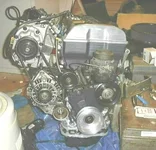Okay,
More questions regarding the feasibility of supercharging.
I've settled on an Eaton M45 s/c. I think that's all the displacement I'll need for the power gain I'm looking for.
I wanted to use a Rising Rate regulator like the BEGI style but I'm concerned about whether it can step up fast enough to match the boost curve of the screw-type supercharger. Any ideas?
I'm going to try to locate the s/c beneath the stock intake manifold, laying on its side, with an extra inlet and outlet manifold that will interface with the stock airbox and the stock intake manifold. This way, no replacement of the factory manifold is necessary and the supercharger could theoretically be bypassed easily if necessary. Any input? (This is partially due to the fact that I'm no good at welding aluminum and my fiberglass intake manifold prototype definitely won't hold up under boost for very long...as well as having no flow bench to see if my runner sizing is correct.)
It will be driven by a longer version of the stock serpentine belt. Anybody see any drawbacks to this setup?
I will be looking for about 6lbs of boost. How have the turbo kits held up with 6psi as far as detonation goes? I don't think an intercooler will be necessary because of the nature of the supercharger. The intake charge temp should stay much lower than with a turbo. Again, tips are appreciated.
I'm sure more questions will arise as development progresses. I appreciate everyone's input...even those who will say "Just go turbo and save the aggravation." Jackson racing/Moss Motors says they won't even think about going into design/production with an Eaton based kit until the car has been produced for at least 4 years. That gives me plenty of time to finish my kit and install it (after the warranty runs out)!
More questions regarding the feasibility of supercharging.
I've settled on an Eaton M45 s/c. I think that's all the displacement I'll need for the power gain I'm looking for.
I wanted to use a Rising Rate regulator like the BEGI style but I'm concerned about whether it can step up fast enough to match the boost curve of the screw-type supercharger. Any ideas?
I'm going to try to locate the s/c beneath the stock intake manifold, laying on its side, with an extra inlet and outlet manifold that will interface with the stock airbox and the stock intake manifold. This way, no replacement of the factory manifold is necessary and the supercharger could theoretically be bypassed easily if necessary. Any input? (This is partially due to the fact that I'm no good at welding aluminum and my fiberglass intake manifold prototype definitely won't hold up under boost for very long...as well as having no flow bench to see if my runner sizing is correct.)
It will be driven by a longer version of the stock serpentine belt. Anybody see any drawbacks to this setup?
I will be looking for about 6lbs of boost. How have the turbo kits held up with 6psi as far as detonation goes? I don't think an intercooler will be necessary because of the nature of the supercharger. The intake charge temp should stay much lower than with a turbo. Again, tips are appreciated.
I'm sure more questions will arise as development progresses. I appreciate everyone's input...even those who will say "Just go turbo and save the aggravation." Jackson racing/Moss Motors says they won't even think about going into design/production with an Eaton based kit until the car has been produced for at least 4 years. That gives me plenty of time to finish my kit and install it (after the warranty runs out)!

